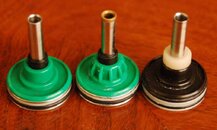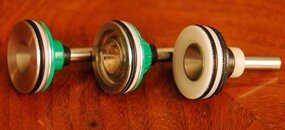You can leave the shims in, but you'd only want to do that if you needed them to get a particular IP beyond the range of adjustment in the Mk 25 retainer.
The adjustable IP extends the adjustment range a bit and perhaps more importantly allows more precise IP adjustment than 5 or 10 psi per shim.
On the other hand, the adjustable shim adds one more thing that can leak. It's common on the Mk 25 to have a o-ring sealing between the seat/seat retainer joint and the first stage body (similar to the o-ring inside the Mk 10) that was not really needed on the Mk 20. It's not all that uncommon for a Mk 25 without the extra o-ring to have a leak through the adjustable portion of the seat retainer. In my opinon the adjustable seat retainer is more of a convenience for a reg tech than an asset for a diver and the Mk 25 was overall better off without it - which would make it technically a Mk 20.
So unless you have a need to match the IP's on mulitple first stages to within 1-2 psi to allow swapping of very finely tuned second stages, I'd advise against that particular upgrade on a Mk 20. If you do upgrade, feel free to send me your old retainer as I'd love to have some on hand to convert Mk 25's to less leak prone Mk 20 status.
An upgrade that is very worthwhile on a Mk 20 is to upgrade to the composite Mk 25 piston. Late production Mk 20's had them to start with. Early Mk 20's had an all stainless steel piston that is quite reliable, but not as well suited to cold water. Mid production Mk 20's had a brass tipped piston that was truly horrible as it had a mushy lockup and sufferred from chronic IP creep.
The attached thumb nails show various views with the early, mid and late production pistons arranged left to right. The piston bushings changed over time with a couple different shapes and colors as did the little rubber boot on the stem which started out in black, then in white, then in a much wider two piece white material, so there are actually numerous combinations you may encounter depending on what parts may have been upgraded over the service history of the reg.
In addition to differences in the seating edges, the piston head went from solid stainless steel to a lighter milled version to the latest composite version. The early versions also used a single o-ring with a white backing ring, (and in the UL version 2 backing rings and one o-ring) while the composite piston uses 2 o-rings and no backing rings. There are also technically 2 versions of the composite piston with the latest one having a "mirror polished" stem, but there is not much difference in the finish, especially after they have been in use a season or two.







